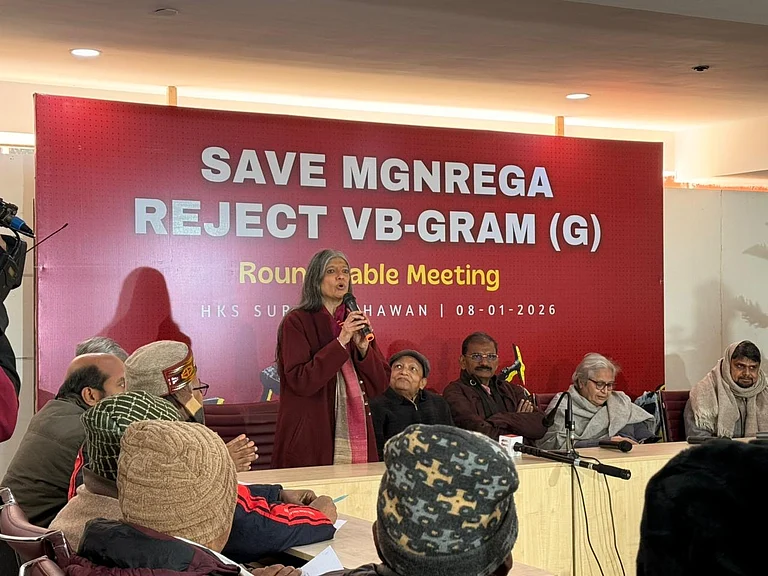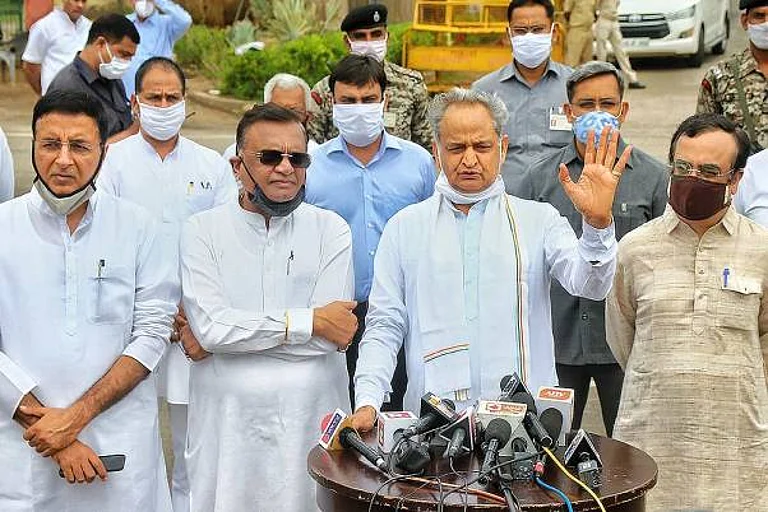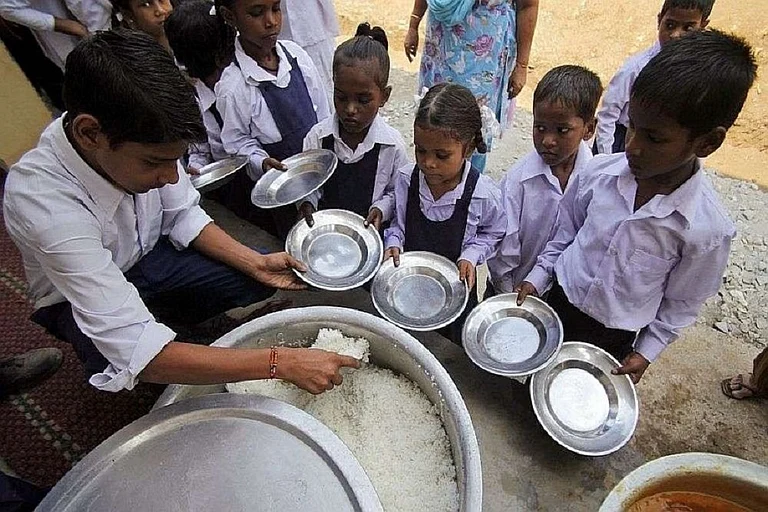With Keerthana Satheesh
Narayan Lal is a migrant worker who lives alone. For him, time is of the essence. A few hours of missed work can mean a loss of a few hundred rupees of income that day. Residing in a humble abode devoid of cooking facilities, he grapples with the daunting challenge of securing his daily sustenance. His reliance solely on external food sources complicates matters further. However, a glimmer of hope emerges in the form of the ‘Indira Rasoi’, conveniently located near his workplace.
The Indira Rasoi, a publicly funded community kitchen, offers a beacon of promise to individuals like Narayan, providing a simple yet wholesome meal at an affordable rate. For a mere Rs 8, the Rasoi extends a generous thali comprising five rotis, a serving of dal, and a vegetable side dish. This seemingly marginal cost holds immense value for Narayan, offering him a much-needed source of affordable nutrition.
The issue of hunger has been a long challenge to India. Multiple government initiatives have aimed to combat the hunger issue, such as the National Food Security Act (NFSA) of 2013, mid-day meals in schools, and the targeted public distribution system (PDS). However, there remains a gap in reaching individuals who simply lack cooking facilities or are unable to cook, such as migrant labourers, the elderly, and individuals with disabilities. This gap is where government-funded community kitchens step in as a workable solution. Several state governments have already implemented and established community canteens, such as the Amma Unavagam in Tamil Nadu, the Indira Canteens in Karnataka, and Indira Rasoi in Rajasthan.
How Rajasthan’s ‘Indira Rasoi’ Scheme Works
To understand the Indira Rasoi Scheme in Rajasthan, we visited a total of 25 canteens selected randomly in Udaipur and Chittorgarh. Each Rasoi is independently managed by a non-governmental organisation (NGO), self-help group (SHG), or private players who get funding from the state government. Depending on the organisation that runs the canteen, a lot of canteen qualities can change. One plate of the thali is actually worth Rs 25, of which Rs 8 is paid by the consumer and the remaining Rs 17 is subsidised by the government. Therefore it is important to judge the thali at its worth of Rs 25 rather than the selling price of Rs 8.
Canteens were operating from numerous set-ups. The larger canteens were situated in a spacious hall with a designated kitchen area, while smaller ones were set up in makeshift tenements along the roadside.
The interiors of these Rasois tell a story of uniformity and functionality. Steel benches and tables, arranged systematically, along with a coupon dispensing counter where a computer operator clicks photos of patrons and records their phone numbers on an online portal. The setup of these canteens often included facilities and equipment provided by the government as part of the scheme, such as refrigerators (primarily used to store fresh vegetables), fans, a roti maker, water dispensers, coolers and televisions. However, the functionality of these amenities varied, depending on the commitment of the canteen owner. While most places appeared clean, roadside or highway-based kitchens were less tidy and operated from makeshift setups. Also despite having cleaning supplies, they mainly used mops to clean tables instead of disinfectants. Plates were just rinsed with water, and there was no soap available for proper washing.

Rasois managed by women’s self-help groups (SHGs) seemed to offer a more equitable space. The members went beyond their designated roles to serve patrons, showing flexibility in their responsibilities. For instance, when a handicapped patron with a locomotor disability in his hands visited, the staff broke the roti and soaked it in dal to assist him with eating. On the other hand, food quality at Rasois operated by private organisations appeared subpar, with visibly runny vegetable curries and pulses.
Overall, there was no strict insistence on payment, as staff discussed accommodating patrons who couldn’t pay. The kitchen staff took pride in providing meals and there was no insistence on patrons to provide their mobile numbers as many didn’t own phones. Most of the kitchens had the facility to make rotis but kitchens that were preparing other food items on-site as well were able to serve hot and fresh meals, contrasting with the food at kitchens that received food deliveries via a centralised kitchen, which tended to go stale by noon.
Who Benefits From ‘Indira Rasois’?
While the scheme is being marketed as food for all, it is important to understand who the scheme’s on-ground recipients are. As part of the survey, we interviewed patrons who were having food at the canteen while we visited. Almost all of them were men. The very few females who were present were accompanied by their husbands who made it a point to interject the female respondent at every question as she was answering. This noticeably highlighted the sad reality of the lack of women in public places. It was a conclusion we were not necessarily looking for but one that we unsurprisingly met with.
Among the males, a significant portion comprised daily wage workers who lacked kitchen facilities at their place of residence. Some didn’t even have a stable place of residence. Many were migrant labourers who had shifted to the city recently in hopes of employment. Being away from their families and living alone, the Rasois came as a blessing that not only served food but food with dignity and shelter.
Most of the people in the canteens enjoyed the food. For one token, you get five rotis, and those who wanted more just got another token or paid an extra two rupees for the extra rotis. Many said they found the food homely and convenient. Some were regular patrons who depended on the canteen for two meals a day. We asked them to rate the food out of 10 and the modal answer for that question always was around 8-10, indicating high levels of satisfaction. If not for this Rs 8 thali, they would have to have food from a restaurant or street vendor outside and spend around Rs 50-60 to get the same level of fulfilment and satisfaction. We recall one of the patrons saying “Yahan Khane ke saath saath izzat bhi milti hai (here you also get dignity with food’)”, hinting towards the change where earlier they had to stand along the road or sit at an unclean space while eating from roadside eateries to now when they get benches to sit and get served respectfully.
It’s important to remember that the scheme is not markedly targeting any particular section of the population. It does not exclude any section through caste or class lines. On paper, the Rs 8 thali is for everyone. The universality of this scheme is what makes it remarkably potent as India shares the world’s largest burden of undernourished population, constituting more than 194.4 million people which itself makes a strong case for providing fresh nutritious meals at affordable prices both on fiscal and welfare grounds. If its provisions are narrowed as we have seen with the targeted public distribution system (TPDS), the chances of wrongful exclusion of needy individuals would be more than the chances of inclusion of individuals who may not need the benefit. Moreover, such a scheme could contribute to enhancing the workforce by addressing the food concerns of a considerable portion of migrant labourers, potentially boosting local industries and businesses. Moreover when a scheme is erroneously labelled and sidelined as “for the poor”, it becomes easier to cut corners on aspects like quality and hygiene. This is where it becomes important to increase awareness of the scheme.
Scope Of Improvement
While the canteens are generally doing well, there certainly are areas where these canteens could enhance their services. Some patrons expressed dissatisfaction with the limited variety in the menu, suggesting a desire for more seasonal vegetables to avoid monotony. Additionally, none of the canteens offered protein-rich options such as chickpeas or soybeans — the inclusion of these in meals would be a nutritious addition to the whole meal. There were also requests for packing and delivery services to cater to individuals who do not have time to eat at the canteen.
At Kapasan, a tehsil of Chittorgarh, we discovered that all the canteens were shut down. Upon investigation, we learned that a single NGO had been awarded the tenders for all the canteens in the area and they were forced to close due to delayed payments from the government for unknown reasons. Enhancing transparency in settling accounts of canteen could potentially prevent such situations from occurring in the future.
There is also room for improvement regarding hygiene. Providing hairnets and gloves for cooks and servers along with ensuring the availability of soap for washing dishes, would be a good step in this direction.
Community Kitchens A Boon For Urban Poor
Narayan Lal is not an isolated story. Millions of urban poor who moved to cities in search of work need an urgent food safety net and a policy designed for them is long overdue. The widespread adoption of community kitchens nationwide could serve as a pivotal solution.
Merely distributing rations falls short of resolving their predicaments as a significant number of individuals relying on these kitchens encounter difficulties in preparing meals, falling outside the ambit of traditional food security programs.
Without access to these community cooking spaces, these individuals often resort to expensive outside meals, compromising the nutritional value of their food. Moreover, embracing the concept of community kitchens not only addresses sustenance concerns but also safeguards the dignity of beneficiaries. These spaces offer more than just meals; they provide a sense of warmth and respect to those seeking affordable nourishment.





















